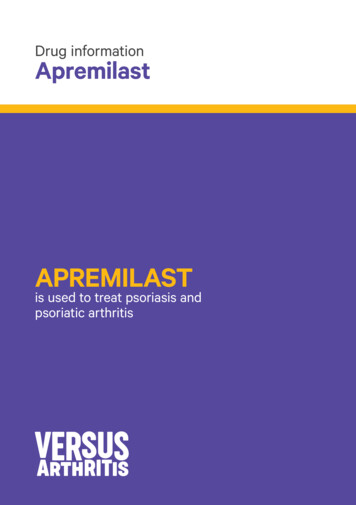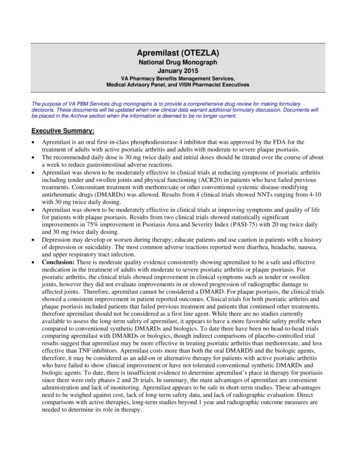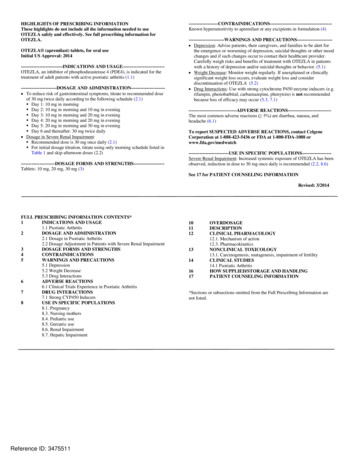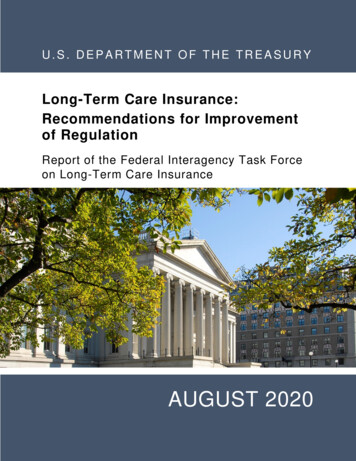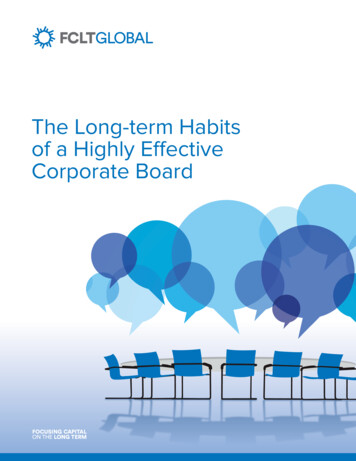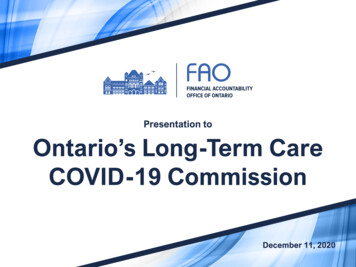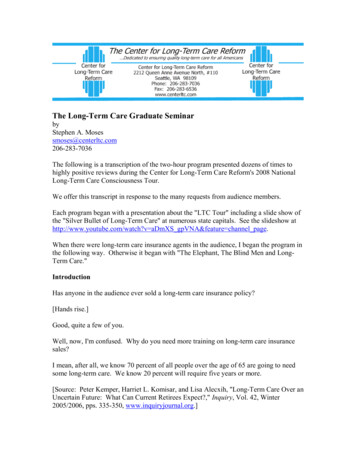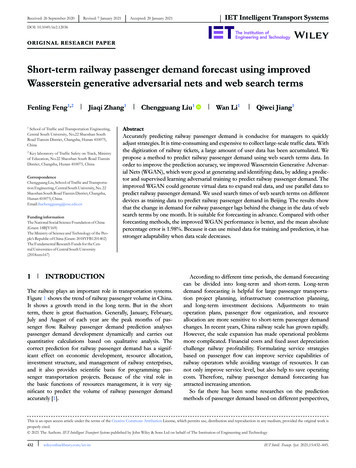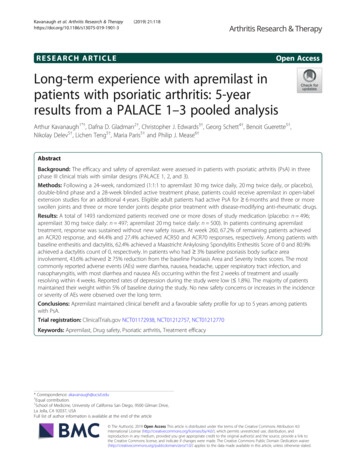
Transcription
Kavanaugh et al. Arthritis Research & 019) 21:118RESEARCH ARTICLEOpen AccessLong-term experience with apremilast inpatients with psoriatic arthritis: 5-yearresults from a PALACE 1–3 pooled analysisArthur Kavanaugh1*†, Dafna D. Gladman2†, Christopher J. Edwards3†, Georg Schett4†, Benoit Guerette5†,Nikolay Delev5†, Lichen Teng5†, Maria Paris5† and Philip J. Mease6†AbstractBackground: The efficacy and safety of apremilast were assessed in patients with psoriatic arthritis (PsA) in threephase III clinical trials with similar designs (PALACE 1, 2, and 3).Methods: Following a 24-week, randomized (1:1:1 to apremilast 30 mg twice daily, 20 mg twice daily, or placebo),double-blind phase and a 28-week blinded active treatment phase, patients could receive apremilast in open-labelextension studies for an additional 4 years. Eligible adult patients had active PsA for 6 months and three or moreswollen joints and three or more tender joints despite prior treatment with disease-modifying anti-rheumatic drugs.Results: A total of 1493 randomized patients received one or more doses of study medication (placebo: n 496;apremilast 30 mg twice daily: n 497; apremilast 20 mg twice daily: n 500). In patients continuing apremilasttreatment, response was sustained without new safety issues. At week 260, 67.2% of remaining patients achievedan ACR20 response, and 44.4% and 27.4% achieved ACR50 and ACR70 responses, respectively. Among patients withbaseline enthesitis and dactylitis, 62.4% achieved a Maastricht Ankylosing Spondylitis Enthesitis Score of 0 and 80.9%achieved a dactylitis count of 0, respectively. In patients who had 3% baseline psoriasis body surface areainvolvement, 43.6% achieved 75% reduction from the baseline Psoriasis Area and Severity Index scores. The mostcommonly reported adverse events (AEs) were diarrhea, nausea, headache, upper respiratory tract infection, andnasopharyngitis, with most diarrhea and nausea AEs occurring within the first 2 weeks of treatment and usuallyresolving within 4 weeks. Reported rates of depression during the study were low ( 1.8%). The majority of patientsmaintained their weight within 5% of baseline during the study. No new safety concerns or increases in the incidenceor severity of AEs were observed over the long term.Conclusions: Apremilast maintained clinical benefit and a favorable safety profile for up to 5 years among patientswith PsA.Trial registration: ClinicalTrials.gov NCT01172938, NCT01212757, NCT01212770Keywords: Apremilast, Drug safety, Psoriatic arthritis, Treatment efficacy* Correspondence: akavanaugh@ucsd.edu†Equal contribution.1School of Medicine, University of California San Diego, 9500 Gilman Drive,La Jolla, CA 92037, USAFull list of author information is available at the end of the article The Author(s). 2019 Open Access This article is distributed under the terms of the Creative Commons Attribution 4.0International License (http://creativecommons.org/licenses/by/4.0/), which permits unrestricted use, distribution, andreproduction in any medium, provided you give appropriate credit to the original author(s) and the source, provide a link tothe Creative Commons license, and indicate if changes were made. The Creative Commons Public Domain Dedication o/1.0/) applies to the data made available in this article, unless otherwise stated.
Kavanaugh et al. Arthritis Research & Therapy(2019) 21:118IntroductionApremilast, an oral phosphodiesterase 4 inhibitor, hasbeen proven effective in patients with psoriatic arthritis(PsA) [1–3]. Apremilast was studied for the treatment ofPsA in three similarly designed, phase III studies (PsoriaticArthritis Long-term Assessment of Clinical Efficacy[PALACE] 1, 2, and 3) that enrolled disease-modifyinganti-rheumatic drug (DMARD)-experienced patients [1–3].These studies included an open-label extension phase toevaluate the effects of long-term exposure to apremilast.We now report the final long-term findings for PALACE 1,2, and 3 in patients with active PsA who received apremilast for up to 260 weeks.MethodsStudy designPALACE 1, 2, and 3 were phase III, multicenter, randomized, double-blind, placebo-controlled studies. The threestudies used the same study design and have been previously described [1–3]. Briefly, each study comprised a24-week, randomized, double-blind, placebo-controlledphase; a 28-week blinded active treatment phase; and along-term, open-label extension phase for up to an additional 4 years. Patients were randomly assigned at baseline (1:1:1) to receive placebo, apremilast 30 mg twicedaily, or apremilast 20 mg twice daily. Patients randomized to placebo were re-randomized to apremilast 30 mgtwice daily or 20 mg twice daily at week 16 (early escape)or week 24. Patients who completed 52 weeks of treatment were eligible to enroll in the long-term extension forapremilast treatment for an additional 4 years.Page 2 of 8among those with enthesitis at baseline, and proportionsof patients achieving a dactylitis count of 0 among thosewith dactylitis at baseline. Physical function assessmentsincluded mean change from baseline and achievement ofa minimal clinically important difference (MCID) of 0.35 [8] in the Health Assessment Questionnaire-Disability Index (HAQ-DI) score [9]. Skin involvement wasalso assessed using 75% reduction from the baselinePsoriasis Area and Severity Index (PASI-75) in patientswith psoriasis involving 3% of body surface area atbaseline.Safety assessmentsSafety assessments were conducted at scheduled visits during each treatment phase and in the event of early termination/withdrawal and included collection of adverse events(AEs) as well as physical examination and clinical laboratory findings. The AEs occurring after randomization wereclassified using the Medical Dictionary for Drug RegulatoryActivities Classification System.Statistical analysesData were pooled across the three studies. Efficacy datawere analyzed descriptively by time point using all available data; analyses through week 260 were based onobserved data without imputation for missing data.Safety outcomes were analyzed descriptively for all patients who received one or more doses of apremilast andare presented for the apremilast-exposure periods fromweeks 0 to 52 (relative to the first dose of apremilast),weeks 52 to 104, weeks 104 to 156, weeks 156to 208, and weeks 208.PatientsAs previously described, patients were adults with activePsA for 6 months who met the Classification Criteriafor Psoriatic Arthritis (CASPAR) [4] and had three ormore swollen joints and three or more tender joints despite prior exposure to conventional or biologicDMARDs [1–3]. Patients enrolled in PALACE 3 alsohad active skin disease with at least one plaque psoriasislesion that was 2 cm in size [3].Study outcomesEfficacy assessmentsEfficacy endpoints included rates of patients achieving 20% improvement in American College of Rheumatology response criteria (ACR20) (primary endpoint),ACR50, and ACR70 responses, modified for PsA usingthe 76 swollen joint count (SJC) and 78 tender jointcount (TJC) (i.e., inclusion of distal interphalangealjoints of the toes and carpometacarpal joints to totaljoint counts) [5, 6]; changes from baseline in SJC andTJC; proportions of patients achieving a Maastricht Ankylosing Spondylitis Enthesitis Score (MASES) [7] of 0ResultsPatientsAcross PALACE 1–3, 1493 patients were randomizedand received one or more doses of study medication(placebo: n 496; apremilast 30 mg twice daily: n 497;apremilast 20 mg twice daily: n 500). Baseline patientdemographic and disease characteristics have been previously described [1–3] and were comparable acrosstreatment groups. Among patients randomized to apremilast 30 mg or 20 mg at baseline, 44.5% (221/497) and42.4% (212/500) completed week 260, respectively.Among patients randomized to placebo at baseline andswitched to apremilast 30 mg or 20 mg at week 16 or 24,49.1% (110/224) and 41.8% (92/220) completed week260, respectively. Of those who received apremilast 30mg or 20 mg entering week 52, regardless of when initiated (baseline, week 16, or week 24), 63.2% (331/524)and 58.7% (304/518) completed 260 weeks, respectively.A total of 684 patients had 208 weeks of exposure toapremilast (20 mg, n 320; 30 mg, n 364). Over theapremilast-exposure period, the most commonly cited
Kavanaugh et al. Arthritis Research & Therapy(2019) 21:118Page 3 of 8reasons for study discontinuation were withdrawal of consent by patient (18.0%), lack of efficacy (17.6%), and adverse event (11.9%). Other reasons for discontinuationincluded lost to follow-up (2.6%), non-compliance (1.2%),protocol violation (0.6%), death (0.5%), and “other” (3.3%).Efficacy outcomesOf patients receiving apremilast 30 mg twice daily, 55.3%achieved an ACR20 response at week 52; at week 260,67.2% of patients who continued apremilast treatmentachieved an ACR20 response. Similarly, ACR50 andACR70 responses were sustained over 260 weeks withcontinued treatment (Fig. 1, Additional file 1: Table S1).Mean SJC and TJC improved by 63.3% and 49.8% atweek 52, with improvements reaching 82.3% and 72.7%,respectively, with continued treatment at week 260(Fig. 2, Additional file 1: Table S1).Among patients with enthesitis or dactylitis at baseline, mean changes in MASES and dactylitis at week 260were 2.9 and 2.8, respectively. The proportions ofthose achieving a MASES of 0 or a dactylitis count of 0increased over 52 weeks and were maintained throughweek 260 with continued apremilast 30 mg treatment(Fig. 3, Additional file 1: Table S1).Improvements in physical function were maintainedthrough week 260 in patients who continued receivingapremilast 30 mg twice daily, including mean change inHAQ-DI and the proportion achieving a HAQ-DI MCID 0.35 (Fig. 4, Additional file 1: Table S1).Among patients with plaque psoriasis involving 3%of the body surface area at baseline, the proportion ofpatients achieving PASI-75 response was generallymaintained with continued treatment, with 43.6% of patients having a PASI-75 response at week 260 (Additional file 1: Figure S1 and Additional file 1: Table S1).Pooled results for apremilast 30 mg twice daily wereconsistent with the results observed in the individualstudies for all outcomes, including ACR20 responses(Additional file 1: Figure S2). Apremilast 20 mg twicedaily also demonstrated improvements in the signs andsymptoms of PsA (Additional file 1: Table S1).Safety outcomesMost AEs were mild or moderate in severity with bothapremilast doses over weeks 0 to 52. During weeks 0to 52, AEs occurring in 5% of apremilast-exposed patients included diarrhea, nausea, headache, upper respiratory tract infection, and nasopharyngitis. Mostdiarrhea and nausea AEs were reported within the first2 weeks of treatment and usually resolved within 4weeks; the frequency of gastrointestinal AEs decreasedwith longer apremilast exposure, and the frequency ofother common AEs decreased or remained stable withprolonged exposure (Table 1).No new safety concerns or increases in the incidenceor severity of AEs were seen with exposure over 260weeks (Table 1). Discontinuations due to AEs duringweeks 0 to 52 occurred in 7.6% of combined apremilast patients. In the longer exposure periods, 2.5% ofpatients discontinued treatment because of AEs. Themost frequently reported AEs leading to discontinuationof apremilast were diarrhea, nausea, and headache andwere primarily reported during the 0- to 52-weekperiod (Table 2).Patients achieving ACRresponses (% with 95% 1.9%016 2452657891104 117 130 143 156 169 182 195 208 221 234 247 260Study WeekACR20, 20ACR50, 24ACR70, 25040Fig. 1 ACR responses in PsA patients receiving apremilast 30 mg up to 260 weeks. Data as observed. The analysis includes all patient data,including the placebo-controlled phase, regardless of when the patients started taking apremilast (baseline, week 16, or week 24). Theproportions of psoriatic arthritis (PsA) patients achieving ACR20, ACR50, or ACR70 responses at study visits up to week 260 are shown. Error barsrepresent 95% confidence interval (CI). n represents the number of patients with data available at that time point
Kavanaugh et al. Arthritis Research & Therapy(2019) 21:118Page 4 of 8Study Week016 244052657891 104117 130 143 156 169 182 195 208 221 234 247 2600TJCSJCMean percent changesfrom baseline (with 95% CI)-20-40 49.8% 65.1%-60 69.2% 68.1% 72.7% 63.3%-80 77.2% 81.1% 81.4% 82.3%-100Apremilast 30 mg BID, 28Fig. 2 SJC/TJC improvements in PsA patients receiving apremilast 30 mg up to 260 weeks. Data as observed. The analysis includes all patientdata, including the placebo-controlled phase, regardless of when the patients started taking apremilast (baseline, week 16, or week 24). The meanpercentage changes in swollen joint count (SJC) and tender joint count (TJC) for psoriatic arthritis (PsA) patients at study visits up to week 260are shown. Error bars represent 95% confidence interval (CI). n represents the number of patients with data available at that time pointSerious AEs occurred at low and similar rates ( 8.4%of combined apremilast patients) during each of the fiveapremilast-exposure periods. Infections and infestationsand musculoskeletal and connective tissue disorderswere the most common classes of serious AE. Each wasreported in 1.8% of combined apremilast patientsduring each apremilast-exposure period. During theplacebo-controlled period, rates of major cardiac events,malignant neoplasms, and serious opportunistic infections were comparable between placebo and apremilast[1–3]. There was no increase in overall rates withlonger-term exposure.In the placebo-controlled period, reports of depressionwere rare but greater with apremilast compared withplacebo (1.2% vs 0.8%). Rates of depression during thelong-term study were low with combined rates of 1.7%,1.8%, 1.5%, 1.6%, and 1.0% for apremilast reported acrossthe five periods examined. No completed suicides occurred during the study. Attempted suicide was reportedby one patient during the weeks 0 to 52Patients achieving MASES ordactylitis count of 0 (% with 95% 4048.7%Dactylitis count of 0MASES of 037.7%200016 2440 52657891104 117 130 143 156 169 182 195 208 221 234 247 260Study WeekMASES 0, n377341329314302293293283278268260 247246240232226218Dactylitis 0, n249226221207201195194186181175173 165162158151148141Fig. 3 Enthesitis/dactylitis improvements in PsA patients receiving apremilast 30 mg up to 260 weeks. Data as observed. The analysis includes allpatient data, including the placebo-controlled phase, regardless of when the patients started taking apremilast (baseline, week 16, or week 24).The proportions of patients achieving a Maastricht Ankylosing Spondylitis Enthesitis Score (MASES) of 0 ( 0 indicating enthesitis) or a dactylitiscount of 0 at study visits up to week 260 are shown. Error bars represent 95% confidence interval (CI). n represents the number of patients witheither MASES 1 or dactylitis count 1 at baseline and data available at that time point
Kavanaugh et al. Arthritis Research & Therapy(2019) 21:118Page 5 of 8Fig. 4 Improvements in physical function among PsA patients receiving apremilast 30 mg up to 260 weeks. Data as observed. The analysisincludes all patient data, including the placebo-controlled phase, regardless of when the patients started taking apremilast (baseline, week 16, orweek 24). The proportions of patients achieving a Health Assessment Questionnaire-Disability Index (HAQ-DI) minimal clinically importantdifference (MCID) of 0.35 at study visits up to week 260 are shown. n represents the number of patients with data available at that time pointapremilast-exposure period (following a serious familyaltercation) and one patient during the weeks 52 to 104apremilast-exposure period (history of depression,bipolar affective disorder, physical/emotional abuse).No suicide attempts were reported during the remainingapremilast-exposure periods. The ranges of mean (median) weight changes were between 1.34 kg ( 1.00 kg)and 0.92 kg ( 0.90 kg) with apremilast 30 mg and 1.36 kg ( 1.00 kg) and 0.98 kg ( 0.40 kg) with apremilast 20 mg across exposure periods, with the majority ofpatients maintaining their weight within 5% of baselineduring the study. Weight loss 5% was observed in 21.8%(155/711) of apremilast 30 mg patients and 21.0% (149/708)of apremilast 20 mg patients. Clinically important laboratory abnormalities were generally infrequent, transient,and of similar incidence during all periods (Table 1).Throughout the longer-term apremilast-exposure periods,the majority of patients with normal baseline values for laboratory parameters evaluated continued to maintainvalues within the normal range (Additional file 1: Table S2).DiscussionIn one of the largest cohorts of patients with active PsA,treatment with apremilast was evaluated for up to 5years in the phase III PALACE 1, 2, and 3 studies. Morethan 40% of patients continued apremilast treatment inthe long-term extension studies through 260 weeks.During the long-term open-label extension phases ofthese studies, the population of patients who continuedapremilast treatment for 5 years maintained improvements in signs and symptoms of PsA, including SJC,TJC, and physical function. Enthesitis, dactylitis, andpsoriasis were also improved in patients with these manifestations at baseline. Given that one third of patientsremaining on treatment at week 260 did not achieve anACR20 response, results suggest using outcome measuresother than ACR20 response criteria when evaluating PsAdisease activity. In a separate study characterizing the clinical benefits associated with long-term apremilast treatment in patients who did not achieve an ACR20 responseat week 104, significant improvements in core psoriaticdomains were observed despite the ACR20 non-response[10, 11]. Taken together, this may explain why patientswho fail to achieve an ACR20 response continue onlong-term apremilast treatment.Apremilast continued to demonstrate a favorablesafety profile in patients with active PsA who were previously treated with a DMARD and/or biologic therapies.The rates and types of AEs were consistent throughoutthe three PALACE studies, and no new safety signalswere observed across 5 years of apremilast treatment.A limitation of these studies is that the impact of apremilast on structural disease progression was not assessedin the PALACE clinical trial program. Importantly, theresults from this analysis indicated significant improvements in the numbers of swollen and tender joints over5 years of treatment. Given that improvements in jointinflammation have been associated with the preventionof structural damage [12], it is possible that high levelsof disease control among patients in the PALACE 1–3studies may have been associated with inhibition of disease progression. A limitation of controlled clinical studies is the enrollment of patients with restricted eligibilitycriteria, which may not represent the general populationof patients with PsA. Additionally, although open-labelextensions offer insight into the experience with a giventreatment in the population of patients who do remainon therapy over the long term, efficacy results may be
0 (0.0)Death113 (15.7)108 (15.0)75 (10.4)60 (8.3)41 (5.7)DiarrheaNauseaHeadacheURTINasopharyngitisAEs occurring in 5% of any treatment group/period57 (7.9)AE leading to study withdrawalWeeks 104 to 156Weeks 156 to 208Weeks 208 to 2600/713 (0.0)0/712 (0.0)0/517 (0.0)3/517 (0.6)0/517 (0.0)4/517 (0.8)0/518 (0.0)2/518 (0.4)31 (6.0)27 (5.2)17 (3.3)11 (2.1)1/503 (0.2)2/502 (0.4)0/503 (0.0)0/503 (0.0)0/502 (0.0)1/502 (0.2)29 (5.7)40 (7.9)15 (3.0)8 (1.6)10 (2.0)1/441 (0.2)2/442 (0.5)0/442 (0.0)5/442 (1.1)0/442 (0.0)2/442 (0.5)20 (4.5)24 (5.4)12 (2.7)10 (2.3)12 (2.7)0 (0.0)7 (1.6)4 (0.9)40 (9.0)287 (64.8)1/419 (0.2)1/419 (0.2)0/419 (0.0)2/419 (0.5)1/419 (0.2)2/419 (0.5)30 (7.1)30 (7.1)11 (2.6)4 (0.9)13 (3.1)0 (0.0)10 (2.4)5 (1.2)33 (7.8)273 (64.7)0/399 (0.0)2/401 (0.5)0/401 (0.0)5/401 (1.2)1/401 (0.2)1/401 (0.2)27 (6.7)22 (5.5)8 (2.0)3 (0.7)5 (1.2)2 # (0.5)8 (2.0)4 (1.0)27 (6.7)238 (59.4)0/364 (0.0)2/364 (0.5)0/364 (0.0)2/364 (0.5)4/364 (1.1)2/364 (0.5)26 (7.1)27 (7.4)9 (2.5)6 (1.6)3 (0.8)1¶ (0.3)11 (3.0)5 (1.4)28 (7.7)219 (59.8)2/362 (0.6)4/362 (1.1)0/362 (0.0)5/362 (1.4)1/363 (0.3)1/363 (0.3)24 (6.6)21 (5.8)2 (0.5)1 (0.3)2 (0.5)1** (0.3)5 (1.4)7 (1.9)21 (5.8)179 (49.2)AE adverse event, URTI upper respiratory tract infection*Includes all patients who received apremilast during the time interval relative to the start of apremilast treatment§Multiorgan failure not suspected to be treatment-related‡Motor vehicle accident on study day 489 Cerebrovascular accident on day 1330 in a 69-year-old man, considered unrelated to the study drug; patient had a history of myocardial infarction, atrial fibrillation, and cerebrovascular accident#Stroke on day 1224 in a 58-year-old woman, considered unrelated to the study drug; patient had a history of chronic ischemic heart disease, hypertension, alcoholism, and atrial fibrillation¶Heart failure on day 1462 in a 70-year-old man, considered unrelated to the study drug; patient had a history of ischemic heart disease, arrhythmia, and heart failure**Necrotizing fasciitis of the anterior abdominal wall, refractory hypotensive shock, and acute renal failure considered not related to apremilast by investigator; patient had a history of diabetes mellitusPlatelets 75 109/L4/712 (0.6)0/712 (0.0)0/713 (0.0)2/713 (0.3)Hemoglobin 10.5 g/dL (male) or 5/713 (0.7) 8.5 g/dL (female)Neutrophils 1 109 L5/712 (0.7)1/713 (0.1)Creatinine, 1.7 ULN, μmol/LLeukocytes 1.5 109/L1/713 (0.1)9/713 (1.3)ALT, 3 ULN8/713 (1.1)48 (6.7)71 (9.9)61 (8.5)69 (9.6)20 (3.8)0 (0.0)1‡ (0.2)89 (12.4)11 (2.2)13 (2.5)8 (1.6)39 (7.7)326 (64.2)1§ (0.1)5 (1.0)35 (6.7)316 (60.8)52 (7.2)3 (0.4)40 (5.6)47 (6.5)6 (0.8)507 (70.4)526 (73.0) 1 serious AESelect laboratory assessments, n/m (%)Weeks 52 to 1040/319 (0.0)1/319 (0.3)0/319 (0.0)1/319 (0.3)3/319 (0.9)4/319 (1.3)22 (6.9)18 (5.6)8 (2.5)4 (1.3)6 (1.9)0 (0.0)2 (0.6)5 (1.6)21 (6.6)188 (58.8)30 mg twice20 mg twice30 mg twice20 mg twice30 mg twice20 mg twice30 mg twice20 mg twice30 mg twice20 mg twicedaily (n 721) daily (n 720) daily (n 520) daily (n 508) daily (n 443) daily (n 422) daily (n 401) daily (n 366) daily (n 364) daily (n 320)Weeks 0 to 52Apremilast-exposure period* 1 serious infection 1 AEPatients withPatients, n (%)Table 1 Summary of safety in patients with PsA through 260 weeks of apremilast treatment by treatment periodKavanaugh et al. Arthritis Research & Therapy(2019) 21:118Page 6 of 8
Kavanaugh et al. Arthritis Research & Therapy(2019) 21:118Page 7 of 8Table 2 Adverse events leading to discontinuation in 2 patients in any single exposure period through 260 weeks of apremilasttreatment by treatment periodPatients, n (%) Apremilast-exposure period*Weeks 0 to 52Weeks 52 to 104Weeks 104 to 156Weeks 156 to 208Weeks 208 to 26030 mgtwice daily(n 721)20 mgtwice daily(n 720)30 mgtwice daily(n 520)20 mgtwice daily(n 508)30 mgtwice daily(n 443)20 mgtwice daily(n 422)30 mgtwice daily(n 401)20 mgtwice daily(n 366)30 mgtwice daily(n 364)20 mgtwice daily(n 320)Nausea16 (2.2)8 (1.1)0 (0.0)0 (0.0)0 (0.0)0 (0.0)0 (0.0)0 (0.0)0 (0.0)0 (0.0)Diarrhea15 (2.1)6 (0.8)1 (0.2)0 (0.0)0 (0.0)1 (0.2)0 (0.0)0 (0.0)1 (0.3)0 (0.0)Headache11 (1.5)4 (0.6)0 (0.0)0 (0.0)1 (0.2)0 (0.0)0 (0.0)0 (0.0)0 (0.0)0 (0.0)Vomiting6 (0.8)1 (0.1)0 (0.0)0 (0.0)0 (0.0)0 (0.0)0 (0.0)0 (0.0)0 (0.0)0 (0.0)Dizziness4 (0.6)2 (0.3)0 (0.0)0 (0.0)0 (0.0)0 (0.0)0 (0.0)0 (0.0)0 (0.0)0 (0.0)Upperabdominalpain3 (0.4)4 (0.6)0 (0.0)0 (0.0)0 (0.0)0 (0.0)0 (0.0)1 (0.3)0 (0.0)0 (0.0)Migraine3 (0.4)1 (0.1)0 (0.0)0 (0.0)0 (0.0)0 (0.0)0 (0.0)0 (0.0)0 (0.0)0 (0.0)Fatigue3 (0.4)2 (0.3)0 (0.0)0 (0.0)0 (0.0)0 (0.0)0 (0.0)1 (0.3)0 (0.0)0 (0.0)*Includes all patients who received apremilast during the time interval relative to the start of apremilast treatmentbiased by the discontinuation of patients due to the lackor loss of response and absence of a control arm. Emerging real-world evidence will provide more insight intothe use and effectiveness of apremilast in clinicalpractice.ConclusionsIn this pooled analysis of three long-term extensionstudies, apremilast continued to demonstrate a favorablesafety profile, with no new safety concerns identified,and was generally well tolerated for up to 5 years. Patients who continued therapy demonstrated sustained,clinically meaningful improvements in the signs andsymptoms across various domains of PsA as well as inphysical function.Additional fileAdditional file 1: Figure S1. PASI-75 response in PsA patients receivingapremilast 30 mg twice daily up to 260 weeks. Figure S2. ACR20 responses in PsA patients receiving apremilast 30 mg twice daily up to260 weeks across PALACE studies. Table S1. Efficacy outcomes at week260 in patients with PsA treated with apremilast. Table S2. Clinically important shifts in select laboratory measurements among patients withnormal values at baseline. (DOCX 117 kb)AbbreviationsAE: Adverse event; DMARD: Disease-modifying anti-rheumatic drug; HAQDI: Health Assessment Questionnaire-Disability Index; MASES: MaastrichtAnkylosing Spondylitis Enthesitis Score; PALACE: Psoriatic Arthritis Long-termAssessment of Clinical Efficacy; PASI-75: 75% reduction from the baselinePsoriasis Area and Severity Index score; PsA: Psoriatic arthritis; SJC: Swollenjoint count; TJC: Tender joint countAcknowledgementsThe authors received editorial support in the preparation of this report fromKristin Carlin, RPh, MBA, of Peloton Advantage, LLC, an OPEN Healthcompany, Parsippany, NJ, USA, funded by Celgene Corporation, Summit, NJ,USA, and from Julia R. Gage, PhD, of Gage Medical Writing, LLC, Moorpark,CA, USA, on behalf of Peloton Advantage. The authors, however, directedand are fully responsible for all content and editorial decisions for this report.FundingThis study was sponsored by Celgene Corporation.Availability of data and materialsCelgene is committed to responsible and transparent sharing of clinical trialdata with patients, healthcare practitioners, and independent researchers forthe purpose of improving scientific and medical knowledge as well asfostering innovative treatment approaches. For more information, please rs’ contributionsDDG contributed to the pooled analysis concept and design of the study.BG, ND, LT, and MP contributed to the data acquisition and preparation. AK,DDG, CJE, GS, BG, ND, LT, MP, and PJM contributed to the data analysis andinterpretation and manuscript review. All authors read and approved thefinal manuscript.Ethics approval and consent to participateThe institutional review boards from each participating medical centerapproved the study protocol for each of the three studies. All patientsprovided written informed consent before any study-related procedureswere conducted.Consent for publicationNot applicable.Competing interestsAK has received grant/research support from Abbott, Amgen, AstraZeneca,BMS, Celgene Corporation, Centocor-Janssen, Pfizer, Roche, and UCB. DDGhas received grant/research support from and served as a consultant forAbbVie, Amgen, BMS, Celgene Corporation, Gilead, Janssen, Novartis, Pfizer,and UCB. CJE has received grant/research support from and served as a consultant for AbbVie, BMS, Celgene Corporation, Janssen, Pfizer, Roche, Samsung, Sanofi, and UCB. GS has received grant/research support from andserved as a consultant for Abbott, Celgene Corporation, Roche, and UCB. BG,ND, LT, and MP are employees of Celgene Corporation. PJM has receivedgrant/research support from and served as a consultant for Abbott, Amgen,Biogen Idec, BMS, Celgene Corporation, Eli Lilly, Genentech, Janssen, Novartis,Pfizer, and UCB, and has served on speakers bureaus for Abbott, Amgen,Biogen Idec, BMS, Eli Lilly, Genentech, Janssen, Pfizer, and UCB.
Kavanaugh et al. Arthritis Research & Therapy(2019) 21:118Publisher’s NoteSpringer Nature remains neutral with regard to jurisdictional claims inpublished maps and institutional affiliations.Author details1School of Medicine, University of California San Diego, 9500 Gilman Drive,La Jolla, CA 92037, USA. 2Division of Rheumatology, Krembil ResearchInstitute, Toronto Western Hospital, University of Toronto, Toronto, Ontario,Canada. 3NIHR Wellcome Trust Clinical Research Facility, University HospitalSouthampton, Southampton, UK. g und Universitätsklinikum Erlangen, Erlangen, Germany.5Celgene Corporation, Summit, NJ, USA. 6Rheumatology Clinical ResearchDivision, Swedish Medical Center/Providence St. Joseph Health andUniversity of Washington, Seattle, WA, USA.Received: 12 December 2018 Accepted: 18 April 2019References1. Kavanaugh A, Mease PJ, Gomez-Reino JJ, Adebajo AO, Wollenhaupt J,Gladman DD, et al. Treatment of psoriatic arthritis in a phase 3 randomized,placebo-controlled trial with apremilast, an oral phosphodiesterase 4inhibitor. Ann Rheum Dis. 2014;73(6):1020–6.2. Cutolo M, Myerson GE, Fleischmann R, Liote F, Diaz-Gonzalez F, Van denBosch F, et al. A phase III, randomized, controlled trial of apremilast inpatients with psoriatic arthritis: results of the PALACE 2 trial. J Rheumatol.20
The Creative Commons Public Domain Dedication waiver . applies to the data made available in this article, unless otherwise stated. . 1School of Medicine, University of California San Diego, 9500 Gilman Drive, La Jolla, CA 92037, USA Full list of author information is available at the end of the article Kavanaugh et al. Arthritis Research .
